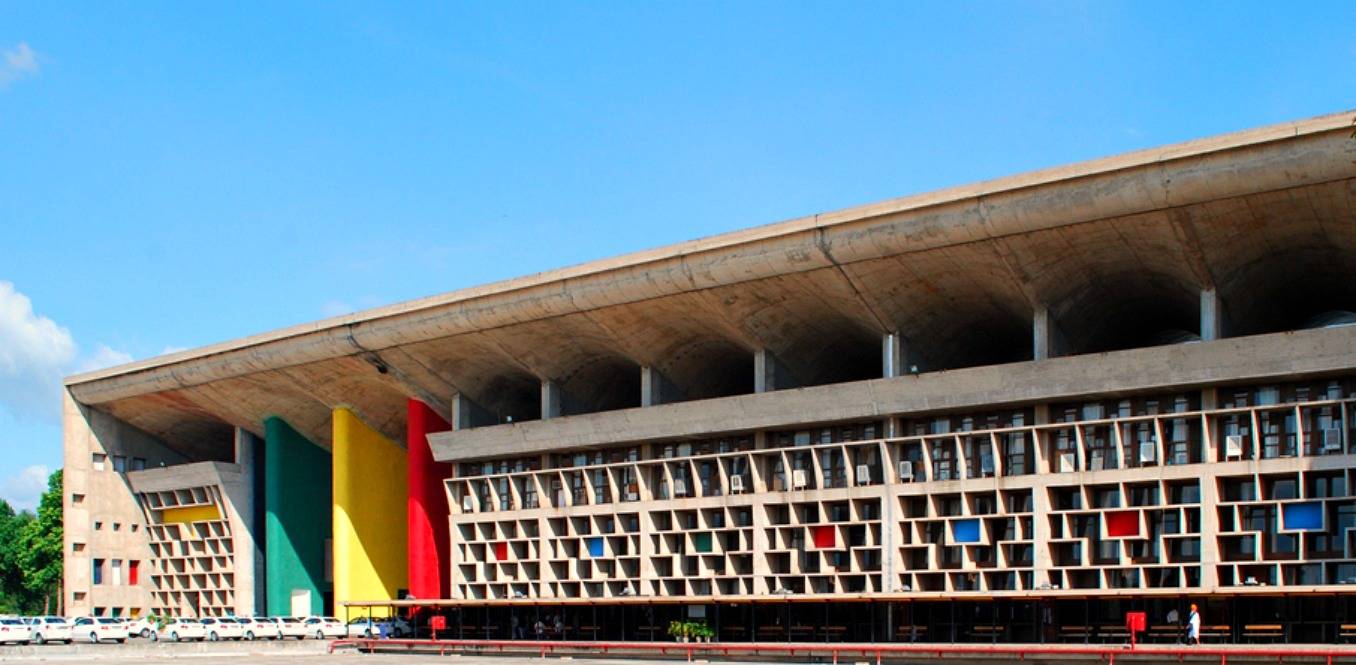Chandigarh, a City in India Designed by Le Corbusier
A little on Chandigarh, a hand-painted city where it’s virtually impossible to get lost.
There are lots of reasons why cities come into being. The first might be a purely practical one, as is the case with metropolises founded near fertile rivers, lakes or land. Another might religious or spiritual: cities born on mythical or sacred places, like Mexico City. Then there are cities born of ideology or for a name, as was the case with Alexandria or the renaming of Russian cities, like Volgograd to Stalingrad.
Sixty years ago, Chandigarh was conceived as a city to celebrate the independence of India. It’s a monument to the country’s entrance into the modern world. The name means “home of Chandi,” the warrior personified as Parvati, a deity of fertility love and devotion. Designed by the legendary architect Le Corbusier, today it’s the capital of the states of Punjab and Haryana and it was thought of as the “perfect city” (if that’s even possible).
About 300 kilometers north of Delhi, Chandigarh came into being in 1947, when the Punjab region was divided between India and the newly created Pakistan. The remaining part, in India, was then without a capital and so the Prime Minister, Jawaharlal Nehru, commissioned Le Corbusier to create a city to replace Lahore, the former Punjab capital now in Pakistani territory. Nehru imagined a city that was “unfettered by the traditions of the past, a symbol of the nation’s faith in the future.” It was a metropolis born of ideas.

Le Corbusier devised a jewel of urbanism that survives as a collection of architecturally modern masterpieces. Even today, the city is substantially different from other cities in India. Every detail of the new metropolis was carefully planned to work perfectly. The architect and his team designed every detail, from the sculptures of the Supreme Court square to the door handles of the offices, and the most important administrative buildings, including the Capitol, the Supreme Court, the Secretariat, Parliament, a Governor’s Palace and a university.
Chandigarh is a city of open public spaces, unlike other large and more motley cities of India. Designed on a grid plane, it’s based on the plans of European cities like Paris but also on the early plans for New Delhi. But the grid of the Punjab capital also includes a series of curves, a hierarchy streets, and lanes for pedestrians and cyclists clearly designated and separated by green areas. A designated commercial street crosses the city from east to west. All of the city’s green areas were designed according to the principles of the Garden City urban movement.
Though it’s one of the most beautiful cities in India and a UNESCO World Heritage site, Chandigarh’s functionality – and indeed Le Corbusier’s master plan – is still criticized. It’s a city alienated from the rest of the country and its culture, but also one that’s sterile, expensive and lacking in social mobility.
Over time Chandigarh has expanded, surpassing the edges of what had been the perfect city. In this context, Le Corbusier’s project still generates relevant questions about utility and practicality in the “invention” of a metropolis, as though it were painting on canvas. We know that cities, like living people, are transformed in organic and uncontrollable ways. The act of conceiving and creating a city from nothing, taking on the role of demiurges, still amazes for its sheer ambition and beauty, especially in a city where every corner was designed with such care.





Related Articles
Why shrinking the size of life is synonymous of well-being
One of the great misunderstandings regarding modern spirituality is that to achieve it requires many things: readings, food, exercise, travel, groups and techniques. But perhaps it should be suggested
What is energy medicine yoga?
Energy Medicine Yoga (EMYoga) is slightly different from other types of Yoga, but it provides the same benefits in addition to a few very specific ones. One of them is that it gives you much more in
Red tea, the best antioxidant beverage on earth
Red tea is considered to be the most unusual of teas because it implies a consistently different preparation process. ––It is believed that its finding came upon surprisingly when traditional green
Is the internet on the verge of self-awareness?
More than 50 years ago, Marshall McLuhan described technology as an extension of our brains, constantly mutating and branching out. “These new media have made our world into a single unit,” the
How art can help us to age, healthy
Perhaps many of us already well know the formula for aging in health and wellness. A balanced diet and, as much as possible, one that’s natural. Keep our brains active and stimulated. Preserve and
Earthanima: documenting the living language of nature
The basic intuition that the Earth is alive and that nature has a language through which it communicates with us is what prompted this wood-art project named Earthanima. For the past couple of years
Dialogue with the Dalai Lama on science and spirituality
The Dalai Lama has been interested in science since he was a child. Over the years he’s visited many laboratories and has attended conferences that discuss consciousness from the scientific point of
Brian Eno's literary recommendations to rebuild society
Artists and authors often get asked what books or records they’d take with them to a deserted island. On principle, this is naturally an extreme anthology: urgency and tragedy guide its selection. It
Bill Mollison, natural ideologue and father of permaculture
Permaculture has established itself as a path towards communitarianism, but one that is in full symbiosis with nature. In practice, it is more than just a combination of agriculture, horticulture
A New Year's resolution for the earth
Worrisome quantities of waste are generated by human populations. Especially in cities, these have reached unprecedented and alarming levels. A largely uncontrolled practice, it affects everything on










